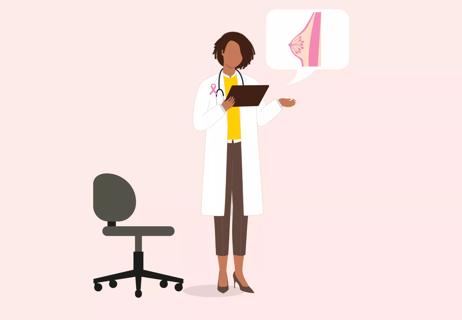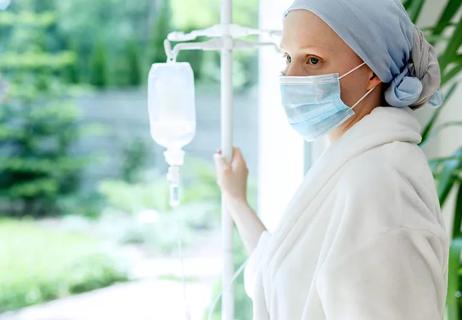Rate of growth depends on cancer type, stage and grade, as well as individual factors

Most cancers have the ability to spread, but whether or not they do (and how fast they spread) depends on a few factors. For breast cancer, the No. 1 way for your doctor to determine how fast your cancer is likely to spread (if at all) comes down to what type of breast cancer you actually have.
Advertisement
Cleveland Clinic is a non-profit academic medical center. Advertising on our site helps support our mission. We do not endorse non-Cleveland Clinic products or services. Policy
“Different types of breast cancer grow at different rates,” explains oncologist Erin Roesch, MD. “It’s difficult to give an overall estimate for how fast breast cancer will spread because every cancer diagnosis is different.”
Here’s a look at what factors may contribute to the spread of breast cancer, plus an outlook for slowing and preventing cancer growth.
By the time someone feels a lump in their breast or receives a breast cancer diagnosis, usually, it’s been growing for years.
“Every type of breast cancer varies based on individual factors and subtypes,” says Dr. Roesch. “The general rule is that we really can’t tell for sure when your cancer popped up. We can look at the subtype of breast cancer to perhaps get a better understanding if it was weeks vs. months for example, but there’s no way to tell for sure when it began.”
As it’s hard to determine how long it takes for breast cancer to develop, it’s also difficult to figure out the average growth rate of breast cancer. Several studies have been conducted to determine the length of time a tumor will double in size, but those numbers vary greatly depending on the type of breast cancer and your own individual characteristics.
Different types of breast cancer tend to behave differently, and because every cancer is different — and every person is, too — it’s hard to say exactly how quickly breast cancer can grow and spread. Still, experts understand that some types of breast cancer tend to be more aggressive and fast moving, while other types typically move slower.
Advertisement
In general, the more your tumor grows, the higher the chance it could spread to nearby tissue and other areas of your body. The speed of your breast cancer growth can be influenced by a number of factors.
Cancer cells have receptors, or special proteins, that impact how they grow and survive. Hormone receptor-positive breast cancers, which rely on the hormone estrogen to grow, tend to be slower moving. But other types can be more aggressive and fast growing. Those include HER2-positive tumors, which rely on a different kind of protein for growth, and triple-negative breast cancer, which lacks hormone receptors and HER2.
Breast cancer is typically given a stage from 0 to IV.
At Stage 0, the cancer is noninvasive and has remained within the milk ducts or lobules in your breast. Invasive breast cancer means the cancer cells have broken through and grown into breast tissue and have the potential to spread elsewhere. When the cancer begins to spread to nearby breast tissue, you’ve reached Stage I.
Stage IV means the cancer has become metastatic and has spread to other organs. Cancer that has spread to other parts of your body is more likely to continue to spread. The higher stage of breast cancer you have, the potentially greater risk of the cancer spreading.
When you’re diagnosed with breast cancer, your doctor will give your cancer a grade from 1 to 3 based on how similar your cancer cells look compared to normal cells. A higher grade means a more aggressive tumor and a possibly higher chance that the cancer will grow and spread to other areas of your body.
People who are younger tend to have more aggressive types of breast cancer compared to people who are older. People who are older are more likely to develop hormonally driven types of breast cancer, which tend to be slower moving, but not always. These breast tumors are more common in women and people assigned female at birth (AFAB) before menopause, likely because of the amount of estrogen their bodies produce.
If breast cancer is hereditary, your risk of breast cancer increases. Some women and people AFAB with these genetic mutations have a higher risk of developing breast cancer at a younger age, which we know tends to cause more aggressive forms of breast cancer.
Your cancer team will determine how likely or fast your breast cancer may spread based on your breast cancer subtype, stage and individual factors. Although breast cancer experts can hypothesize and estimate the speed of cancer growth, every breast cancer is different and distinctive to that person.
Advertisement
Like any type of cancer, there are factors that can put you at higher risk. For breast cancer, these include things like smoking, unhealthy diet, lack of exercise and not performing monthly self-breast exams. It’s also important to make sure you get your annual mammogram for breast cancer screening.
Other risk factors can include using hormone-based prescriptions, how many children you’ve had in the past, getting older and at what age you got your period and went through menopause.
“In some instances, you can’t necessarily prevent breast cancer, but you can sometimes slow it down, stop it from spreading or reduce the size of the tumor,” notes Dr. Roesch. “You can do this by taking your medications as directed, following through with treatments, going to your appointments and being involved in your cancer care.”
You’re in control of taking your medication correctly, eating a healthy diet, participating in an exercise program and managing stress. All of these things can contribute to a stronger physical body and better mental attitude — both of which can have a positive impact on your breast cancer diagnosis.
Advertisement
Learn more about our editorial process.
Advertisement

Working has its benefits, but it may require some modifications — and that’s OK

Working has its benefits, but it may require some modifications — and that’s OK

Palliative care offers a comprehensive network of support at any stage, from diagnosis to treatment and beyond

Lumps may move and you may feel pain, but breast discharge typically isn’t a sign of cancer

Treatments like chemotherapy and radiation can cause your red blood cell levels to decrease

Learn about BRCA and other genes that raise the risk of breast cancer

A breast cancer specialist discusses if and when it's the right decision

Most recommended precautions center around minimizing bruising or swelling

Type 2 diabetes isn’t inevitable with these dietary changes

Applying a hot or cold compress can help with pain